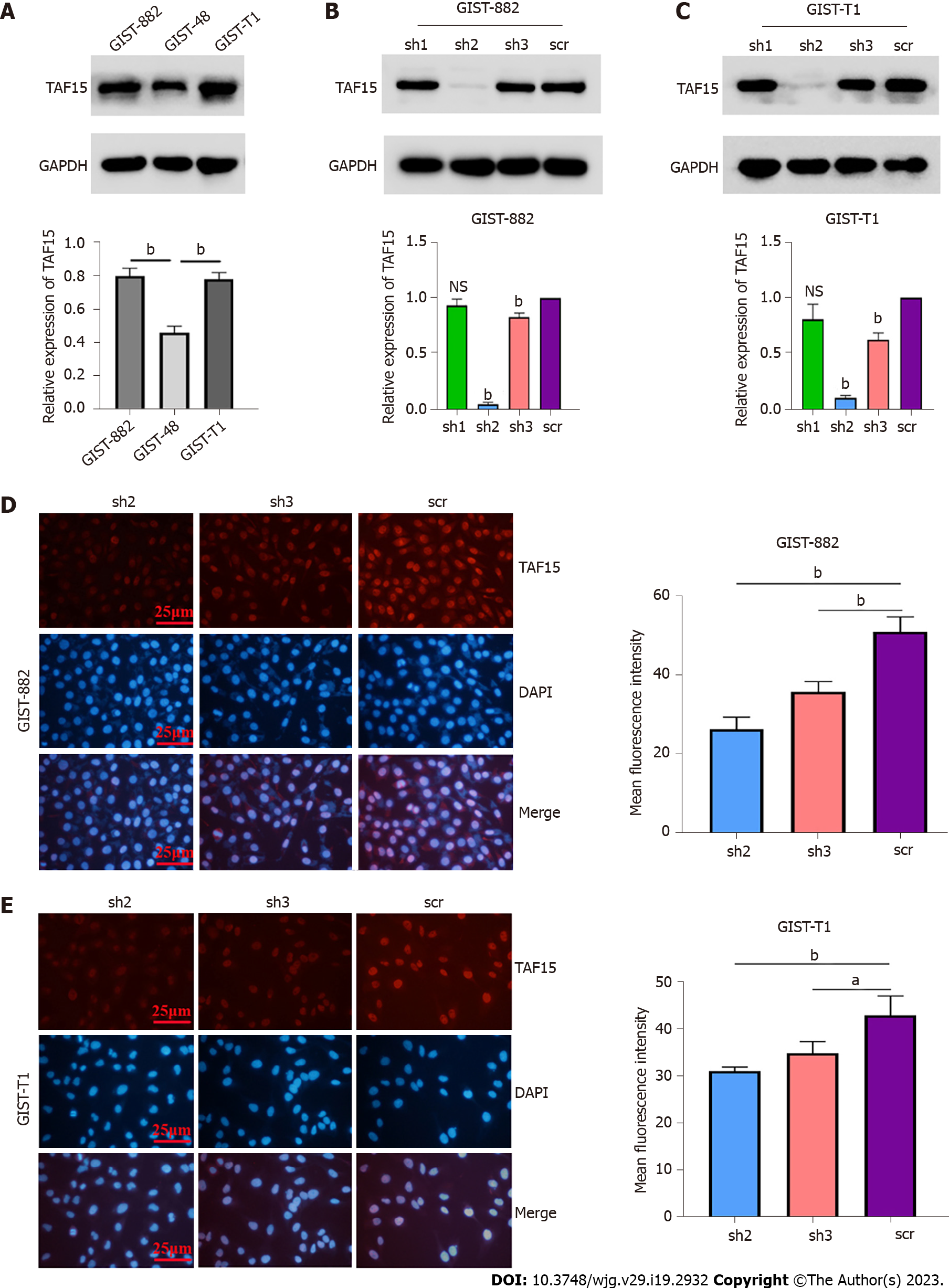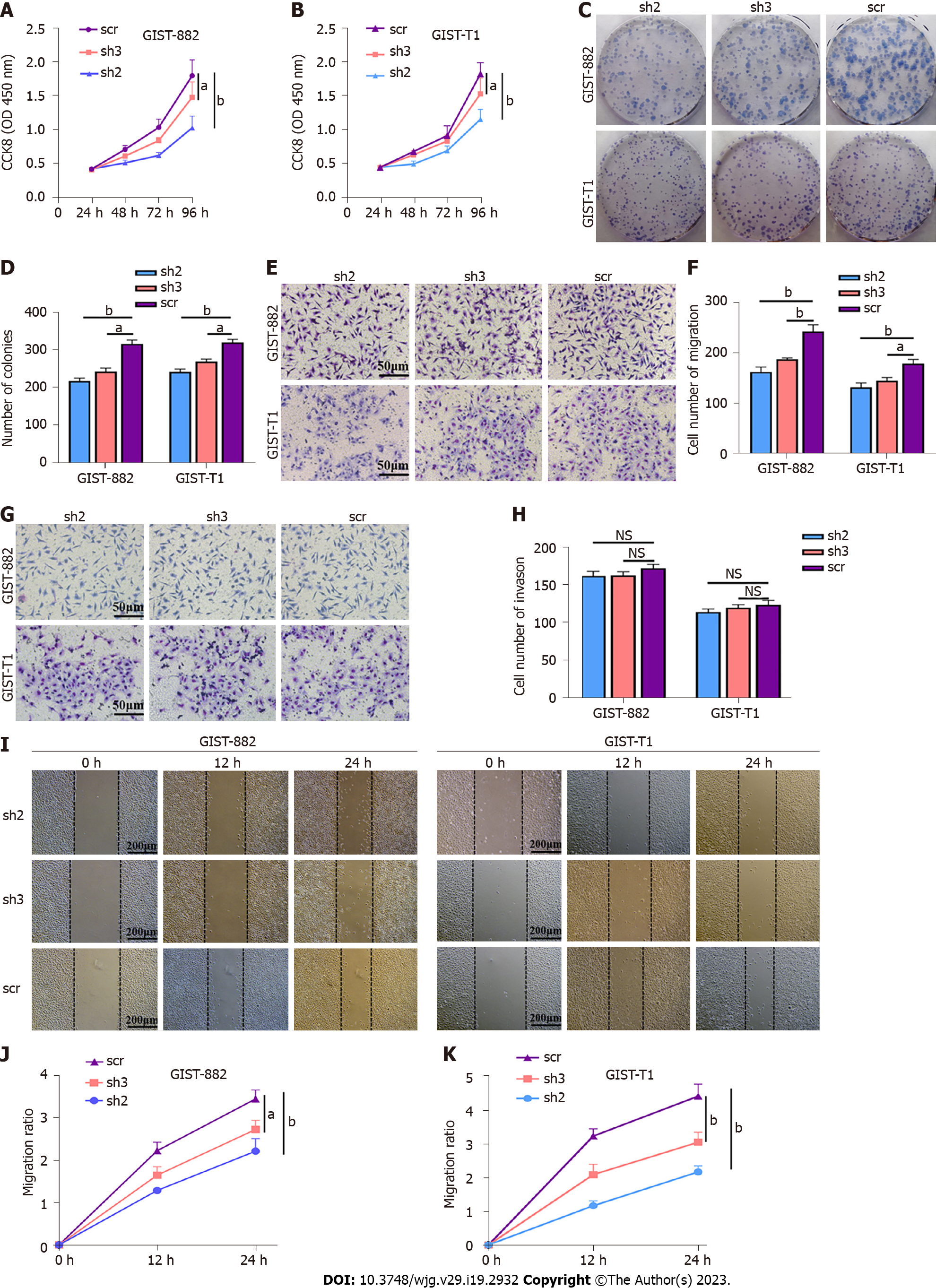Copyright
©The Author(s) 2023.
World J Gastroenterol. May 21, 2023; 29(19): 2932-2949
Published online May 21, 2023. doi: 10.3748/wjg.v29.i19.2932
Published online May 21, 2023. doi: 10.3748/wjg.v29.i19.2932
Figure 1 Differentially expressed proteins in gastrointestinal stromal tumor samples.
A: Proteomic analysis identified the differentially expressed proteins in gastrointestinal stromal tumor (GIST) patients; B: Venn diagram showed the number of identified differentially expressed proteins in the subgroups of GIST; C and D: Western blotting identified that the expression level of TATA-box-binding protein-associated factor 15 (TAF15) was significantly increased in tumor tissues compared with matched normal tissues in all 18 GIST samples. P values were calculated using the Student’s t-test; E: Immunohistochemical analysis verified the expression of TAF15 using 161 GIST tumor tissues and 18 matched normal tissues (representative images are shown and red arrows indicate positive staining); F: Total immunostaining score of TAF15 protein in tumor tissues and matched normal tissues of GIST; G: Total immunostaining score of TAF15 proteins in the GIST subgroup. P values were calculated using the Student’s t-test or one-way analysis of variance. bP < 0.01. NS: No significance between groups; NIH-H: National Institutes of Health high risk; NIH-I: National Institutes of Health intermediate risk; NIH-L: National Institutes of Health low risk; NIH-VL: National Institutes of Health very low risk; IHC: Immunohistochemical; T: Tumor tissues; N: Normal tissues; FC: Fold change; TAF15: TATA-box-binding protein-associated factor 15.
Figure 2 The knockdown efficiency of short hairpin-TATA-box-binding protein-associated factor 15 in gastrointestinal stromal tumor cell lines.
A: Western blotting to detect the expression level of TATA-box-binding protein-associated factor 15 (TAF15) in gastrointestinal stromal tumor(GIST) cell lines. P values were calculated by one-way analysis of variance; B and C: TAF15 was knocked down using three short hairpin (sh) RNAs (sh1, sh2, and sh3) and scrambled shRNA (scr) as control in GIST-882 and GIST-T1 cells. The results showed that sh2 and sh3 could reduce the expression level of TAF15 significantly when compared to scr as tested by western blotting analysis; D and E: The fluorescence intensity of TAF15 in sh2 and sh3 was reduced significantly when compared to scr in GIST-882 and GIST-T1 cells as tested by a cell immunofluorescence assay. P values were calculated using the Student’s t-test. aP < 0.05, bP < 0.01. NS: No significance between groups; GIST: Gastrointestinal stromal tumor; TAF15: TATA-box-binding protein-associated factor 15; sh1: shRNA1 targeting TATA-box-binding protein-associated factor 15; sh2: shRNA2 targeting TATA-box-binding protein-associated factor 15; sh3: shRNA3 targeting TATA-box-binding protein-associated factor 15; scr: Scrambled shRNA.
Figure 3 TATA-box-binding protein-associated factor 15 regulated the proliferation and migration of gastrointestinal stromal tumor cells.
A and B: Cell counting kit-8 assay was performed to detect the proliferation of gastrointestinal stromal tumor (GIST)-882 and GIST-T1 after cell transfection. P values were calculated using the Student’s t-test; C and D: A colony formation assay identified the proliferative ability of GIST-882 and GIST-T1 after cell transfection. Statistical analyses were performed using the Student’s t-test; E-H: A transwell assay was performed to analyze the migratory and invasive ability of GIST-882 and GIST-T1 cells after transfection. P values were calculated using the Student’s t-test; I-K: A wound healing assay was conducted to confirm the migratory ability of GIST-882 and GIST-T1 cells after transfection. P values were calculated using the Student’s t-test. aP < 0.05, bP < 0.01. GIST: Gastrointestinal stromal tumor; NS: No significance between groups; sh2: shRNA2 targeting TATA-box-binding protein-associated factor 15; sh3: shRNA3 targeting TATA-box-binding protein-associated factor 15; scr: Scrambled shRNA; CCK8: Cell counting kit-8.
Figure 4 TATA-box-binding protein-associated factor 15 promoted the proliferation and migration of gastrointestinal stromal tumor cells by activating the RAF1/MEK/ERK pathway.
A: Western blotting analysis detected the protein level of pRAF1/RAF1, pMEK/MEK and pERK/ERK in gastrointestinal stromal tumor (GIST)-882 and GIST-T1 after cell transfection; B-D: The phosphorylation levels of RAF1, MEK and ERK1/2 were significantly decreased inshRNA2 targeting TATA-box-binding protein-associated factor 15 and shRNA3 targeting TATA-box-binding protein-associated factor 15 when compared to the scrambled shRNA in GIST cell lines. Statistical analyses were executed by the Student’s t-test. bP < 0.01. GIST: Gastrointestinal stromal tumor; sh2: shRNA2 targeting TATA-box-binding protein-associated factor 15; sh3: shRNA3 targeting TATA-box-binding protein-associated factor 15; scr: Scrambled shRNA.
Figure 5 TATA-box-binding protein-associated factor 15 suppressed tumor growth of gastrointestinal stromal tumor cells in vivo.
A-C: The volumes and weights of tumors in the shRNA2 targeting TATA-box-binding protein-associated factor 15 group were significantly smaller than the scrambled shRNA group. Statistical analyses were performed using the Student’s t-test; D and E: Western blotting analysis was used to confirm the expression levels of TATA-box-binding protein-associated factor 15 in xenograft tumors; F-I: Western blotting analysis confirmed the protein levels of pRAF1/RAF1, pMEK/MEK and pERK/ERK in xenograft tumors. P values were calculated using the Student’s t-test. aP < 0.05, bP < 0.01. TAF15: TATA-box-binding protein-associated factor 15; sh2: shRNA2 targeting TATA-box-binding protein-associated factor 15; scr: Scrambled shRNA.
Figure 6 A schematic diagram of the mechanism of action of TATA-box-binding protein-associated factor 15 in gastrointestinal stromal tumors.
TATA-box-binding protein-associated factor 15 shuttles between the nucleus and cytoplasm and promotes proliferation and migration of gastrointestinal stromal tumor cells by activating the RAF1/MEK/ERK pathway. TAF15: TATA-box-binding protein-associated factor 15.
- Citation: Guo CM, Tang L, Li X, Huang LY. TATA-box-binding protein-associated factor 15 is a novel biomarker that promotes cell proliferation and migration in gastrointestinal stromal tumor. World J Gastroenterol 2023; 29(19): 2932-2949
- URL: https://www.wjgnet.com/1007-9327/full/v29/i19/2932.htm
- DOI: https://dx.doi.org/10.3748/wjg.v29.i19.2932














